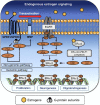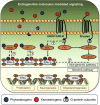The Impact of Estrogen and Estrogen-Like Molecules in Neurogenesis and Neurodegeneration: Beneficial or Harmful?
- PMID: 33762910
- PMCID: PMC7984366
- DOI: 10.3389/fncel.2021.636176
The Impact of Estrogen and Estrogen-Like Molecules in Neurogenesis and Neurodegeneration: Beneficial or Harmful?
Abstract
Estrogens and estrogen-like molecules can modify the biology of several cell types. Estrogen receptors alpha (ERα) and beta (ERβ) belong to the so-called classical family of estrogen receptors, while the G protein-coupled estrogen receptor 1 (GPER-1) represents a non-classical estrogen receptor mainly located in the plasma membrane. As estrogen receptors are ubiquitously distributed, they can modulate cell proliferation, differentiation, and survival in several tissues and organs, including the central nervous system (CNS). Estrogens can exert neuroprotective roles by acting as anti-oxidants, promoting DNA repair, inducing the expression of growth factors, and modulating cerebral blood flow. Additionally, estrogen-dependent signaling pathways are involved in regulating the balance between proliferation and differentiation of neural stem/progenitor cells (NSPCs), thus influencing neurogenic processes. Since several estrogen-based therapies are used nowadays and estrogen-like molecules, including phytoestrogens and xenoestrogens, are omnipresent in our environment, estrogen-dependent changes in cell biology and tissue homeostasis have gained attention in human health and disease. This article provides a comprehensive literature review on the current knowledge of estrogen and estrogen-like molecules and their impact on cell survival and neurodegeneration, as well as their role in NSPCs proliferation/differentiation balance and neurogenesis.
Keywords: 17β-estradiol; Alzheimer’s disease; ERα/β; GPER1/GPR30; Parkinson’s disease; bisphenol A; hormone replacement therapy; neural stem/progenitor cells.
Copyright © 2021 Bustamante-Barrientos, Méndez-Ruette, Ortloff, Luz-Crawford, Rivera, Figueroa, Molina and Bátiz.
Conflict of interest statement
FB-B was employed by company Cells for Cells (Chile). The remaining authors declare that the research was conducted in the absence of any commercial or financial relationships that could be construed as a potential conflict of interest.
Figures



Similar articles
-
Possible role of phytoestrogens in breast cancer via GPER-1/GPR30 signaling.Clin Sci (Lond). 2018 Dec 13;132(24):2583-2598. doi: 10.1042/CS20180885. Print 2018 Dec 21. Clin Sci (Lond). 2018. PMID: 30545896 Review.
-
G protein-coupled estrogen receptor 1 negatively regulates the proliferation of mouse-derived neural stem/progenitor cells via extracellular signal-regulated kinase pathway.Brain Res. 2019 Jul 1;1714:158-165. doi: 10.1016/j.brainres.2019.02.024. Epub 2019 Feb 21. Brain Res. 2019. PMID: 30797747
-
The key involvement of estrogen receptor β and G-protein-coupled receptor 30 in the neuroprotective action of daidzein.Neuroscience. 2013 May 15;238:345-60. doi: 10.1016/j.neuroscience.2013.02.005. Epub 2013 Feb 16. Neuroscience. 2013. PMID: 23419549
-
Localization of estrogen receptor ERα, ERβ and GPR30 on myenteric neurons of the gastrointestinal tract and their role in motility.Gen Comp Endocrinol. 2019 Feb 1;272:63-75. doi: 10.1016/j.ygcen.2018.11.016. Epub 2018 Nov 28. Gen Comp Endocrinol. 2019. PMID: 30502347
-
Neuroprotective effect of estrogen: role of nonsynaptic NR2B-containing NMDA receptors.Brain Res Bull. 2013 Apr;93:27-31. doi: 10.1016/j.brainresbull.2012.10.004. Epub 2012 Oct 17. Brain Res Bull. 2013. PMID: 23085545 Review.
Cited by
-
Organizational Effects of Estrogens and Androgens on Estrogen and Androgen Receptor Expression in Pituitary and Adrenal Glands in Adult Male and Female Rats.Front Neuroanat. 2022 Jun 23;16:902218. doi: 10.3389/fnana.2022.902218. eCollection 2022. Front Neuroanat. 2022. PMID: 35815333 Free PMC article.
-
Selective Activation of G Protein-Coupled Estrogen Receptor 1 (GPER1) Reduces ER Stress and Pyroptosis via AMPK Signaling Pathway in Experimental Subarachnoid Hemorrhage.Mol Neurobiol. 2025 Jan;62(1):871-884. doi: 10.1007/s12035-024-04312-3. Epub 2024 Jun 27. Mol Neurobiol. 2025. PMID: 38935231
-
Association Study of the SLC1A2 (rs4354668), SLC6A9 (rs2486001), and SLC6A5 (rs2000959) Polymorphisms in Major Depressive Disorder.J Clin Med. 2022 Oct 7;11(19):5914. doi: 10.3390/jcm11195914. J Clin Med. 2022. PMID: 36233781 Free PMC article.
-
Emerging Evidence on Membrane Estrogen Receptors as Novel Therapeutic Targets for Central Nervous System Pathologies.Int J Mol Sci. 2023 Feb 17;24(4):4043. doi: 10.3390/ijms24044043. Int J Mol Sci. 2023. PMID: 36835454 Free PMC article. Review.
-
Gender Differences in the Pathogenesis and Risk Factors of Hepatocellular Carcinoma.Biology (Basel). 2023 Jul 11;12(7):984. doi: 10.3390/biology12070984. Biology (Basel). 2023. PMID: 37508414 Free PMC article. Review.
References
-
- Agarwal S., Yadav A., Tiwari S. K., Seth B., Chauhan L. K., Khare P., et al. (2016). Dynamin-related protein 1 inhibition mitigates bisphenol a-mediated alterations in mitochondrial dynamics and neural stem cell proliferation and differentiation. J. Biol. Chem. 291 15923–15939. 10.1074/jbc.m115.709493 - DOI - PMC - PubMed
Publication types
LinkOut - more resources
Full Text Sources
Other Literature Sources
Research Materials

